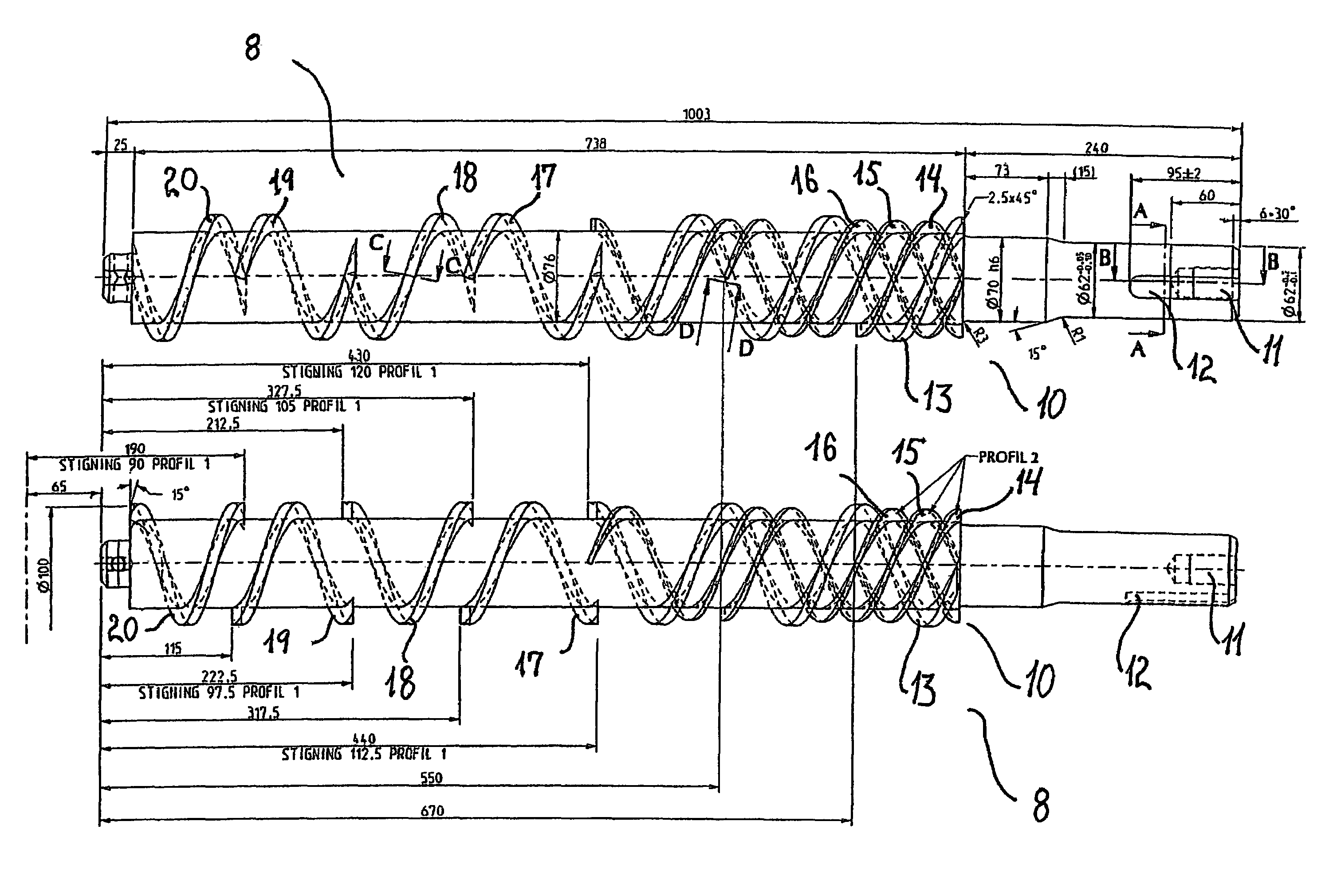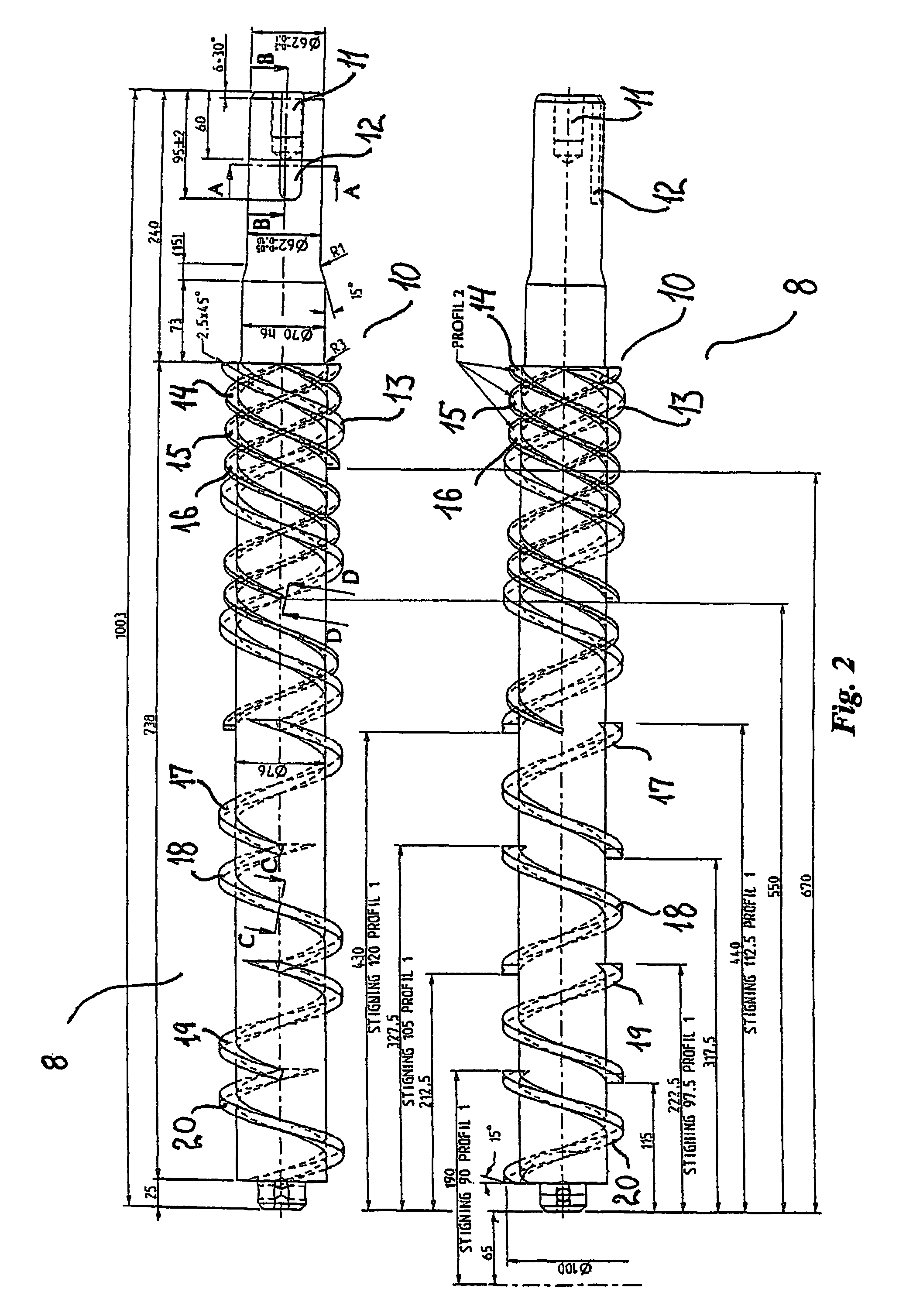[0015]The screw flights are typically fastened to an inner closed core which may be of cylindrical shape but also of another shape, e.g. frusto-conical, in order to vary the open cross-sectional area and thereby the speed of conveyance. The outer edge of the screw flights will for the longest screw flights normally extend to a radius which is constant along the longitudinal axis of the conveyor screw so that the conveyor screw fits into a cylindrical cavity, but also this radius may be varied along the longitudinal axis so that the conveyor screw e.g. fits into a frusto-conical cavity for in this way to vary the open cross-sectional area as well as the surface area of the surface of the cavity with which the conveyed mass comes in contact during the conveyance. The latter can be an advantage if e.g. the heat transfer through the surface is to be increased near the outlet end of the conveyor screw.
[0016]In order to lower the necessary inlet pressure for a conveyance apparatus with the said conveyor screw, it is an advantage that said at least two screw flights extend over an inlet end part of the conveyor screw so that the radially shorter screw flights, e.g. 0,85-0,98 times the radius of the longer screw flight, increases the conveyance near the inlet end and thereby increases the inlet suction of the conveyance apparatus.
[0018]The at least two screw flights extending at a lower radial distance from the longitudinal axis, extend in a preferred embodiment from the inlet end part and in different longitudinal distances form the inlet end part so that the assisting conveyance, which is performed by these radially shorter screw flights, decreases gradually from the inlet end and that the mixing of the mass some distance inside the conveyance apparatus thereby is increased with an increased homogeneity of the mass as a result. The radially shorter screw flights perform preferably the conveyance of the warmer ice cream mass with a lower viscosity and as the temperature drops from the inlet end towards the outlet end the quantity of the ice cream mass with the lower viscosity is reduced and thereby the quantity which is to be conveyed by the radially shorter screw flights. The difference in the extension of the screw flights from the inlet end part amounts in a preferred embodiment of the invention to from 8% to 50%, preferably from 12% to 40% of the total length of the conveyor screw by which is understood the part of the conveyor screw which is in contact with the mass being conveyed.
[0019]It has appeared to be advantageous that the pitch of the screw flights at the inlet end of the conveyor screw is relatively high, i.e. 0.9 to 1.4, preferably 1.1 to 1.3 unlike the normal pitch of the screw flights of such conveyor screws of 0.5 to 1, where the pitch is given as the ratio of the length of one turn in the longitudinal direction of the conveyor screw and the outer diameter of the longest screw flights. With a high screw pitch, a higher conveyance length per rotation of the conveyor screw is achieved and the scraping frequency is reduced per unit length the mass is conveyed. The speed of rotation can thereby also be lower in order to conveyance a given volume of the mass.
[0023]It has further shown to be advantageous that the pitch of the screw flights is reduced along the longitudinal direction of the conveyor screw to 0.7 to 1, preferably 0.8 to 0.9 at an outlet end of the conveyor screw. Thereby, the pressure increases somewhat towards the outlet end, and the ice cream mass or other mass, which is conveyed by means of the conveyor screw, obtains a suitable pressure at the outlet end for feeding into the following manufacturing machines such as extruding apparatuses. A similar effect may, as mentioned previously, be achieved by increasing the diameter of the core of the conveyor screw but as to manufacture, it is preferred to reduce the pitch of the screw flights instead.
[0025]If the conveyor screw is made in such a way that the screw flights extending to the highest radial distance from the longitudinal axis progress discontinuously in the longitudinal direction so that a peripherally extending opening exists between these screw flights at least at one position along the longitudinal direction, it has been found that fluctuations in the discharge quantity per time unit may be reduced and actually completely eliminated. The use of openings in screw flights is known from an extruder, which is described in WO 00 / 44548. It has by the present invention been found to be suitable with from two to eight of such openings in the full length of the conveyor screw, preferably from three to six. Another way to estimate how many openings it is advantageous to provide, is an average distance in the longitudinal direction between the openings of from 1 to 4 times the outer diameter of the screw, preferably form 1.5 to 2.5. The effect of the openings is that the pressure difference between the pressure side and the suction side of the screw flights is equalized which has been found to give a more even pressure distribution in the mass. The high viscosity of the mass results in that the pressure differences in the conveyed mass builds up high local pressure gradients to a greater extent than for masses of low viscosity, as the mass not immediately flows due to the pressure gradient and thereby equalizes it.
 Login to View More
Login to View More 


